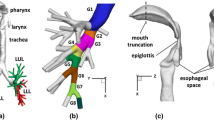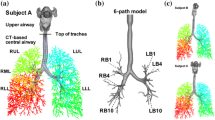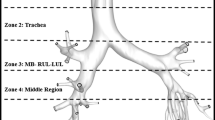Abstract
In this work, we show that a one-dimensional model of the blood flow across the lungs can reproduce the evolution of a bolus versus the time. Solving the differential equation governing the bolus concentration in the framework of this model, we determine the solution which fulfills Gaussian initial boundary conditions. An effective parameter related to the ratio of a diffusion coefficient to the square of the mean speed of the flow is defined. The determination of its numerical values following a semi-empirical approach enables us to know accurately the mean transit time and the cardiac output. The results have been compared to other methods, and were found in good agreement. Such an approach could be of interest in all studies where the knowledge of flow—including micro-circulation—is needed.
Similar content being viewed by others
References
Adams, R., G. J. Hine and C. D. Zimmerman. 1978. Dead time measurements in scintillation cameras under scatter conditions simulating quantitative nuclear cardiography.J. Nucl. Med. 19, 538–544.
Audi, S. H., J. H. Linehan, G. S. Krenz, C. A. Dawson, S. B. Ahlf and D. L. Roerig. 1995. Estimation of the pulmonary capillary transport function in isolated rabbit lungs.J. Appl. Physiol. 78, 1004–1014.
Bassingthwaighte, J. B., F. H. Ackerman and E. H. Wood. 1966. Applications of the lagged normal density curve as a model for arterial dilution curves.Circ. Res. 18, 398–415.
Bassingthwaighte, J. B., I. S. Chan and A. A. Goldstein. 1988. An efficient method for smoothing indicator-dilution and other unimodal curves.Comput. Biomed. Res. 21, 192–202.
Beyer, R. P. 1992. Fitting smooth curves to noisy indicator-dilution and other unimodal data.Comput. Biomed. Res. 25, 144–152.
Dawson, C. A., T. A. Bronikowski, J. H. Linehan and T. S. Hakim. 1983. Influence of pulmonary vasoconstriction on lung water and perfusion heterogeneity.J. Appl. Physiol. 54, 654–660.
Fouad-Tarazi, F. M. and W. J. MacIntyre. 1990. Radionuclide methods for cardiac ouptut determination.Eur. Heart J. 11, 33–40.
Gott, F. S., T. W. Moir, W. J. MacIntyre and W. H. Pritchard. 1961. A mathematical model of dilution curves for flow study.Circ. Res. 9, 607–613.
Hogg, J. C., T. McLean, B. A. Martin and B. Wiggs. 1988. Erythrocyte and neutrophil concentration in the dog lung.J. Appl. Physiol. 65, 1217–1225.
Kelback, H., O. J. Hartling, K. Skagen, O. Munk, O. Henriksen and J. Godtfredsen. 1987. First-class radionuclide determination of cardiac output: an improved gamma camera method.J. Nucl. Med. 28, 1330–1334.
King, R. B., A. Deussen, G. M. Raymond and J. B. Bassingthwaighte. 1993. A vascular transport operator.Am. J. Physiol. 265 (Heart Circ. Physiol. 34), H2196–H2208.
Knopp, T. J. and J. B. Bassingthwaighte. 1969. Effect of flow on transpulmonary circulatory transport functions.J. Appl. Physiol. 27, 36–43.
Lessen, N. A. and W. Perl. 1979.Tracer Kinetic Methods in Medical Physiology. New York: Raven Press.
Lewis, M. L., R. De Caterina and C. Giuntini. 1994. Distribution function of transit times in the human pulmonary circulation.J. Appl. Physiol. 76, 1363–1371.
Margenau, H. and G. M. Murphy. 1976.The Mathematics of Physics and Chemistry, pp. 238–396. New York: R. E. Krieger.
Maseri, A., P. Caldini, S. Permutt and K. L. Zierler. 1970. Frequency function of transit times through dog pulmonary circulation.Circ. Res. 26, 527–543.
Norwich, K. H. and S. Zelin, 1970. The dispersion of indicator in the cardio-pulmonary system.Bull. Math. Biophys. 32, 25–43.
Presson, R. G., C. C. Hanger, Jr., P. S. Godbey, J. A. Graham, T. C. Lloyd, Jr. and W. W. Wagner, Jr. 1994. Effect of increasing flow on distribution of pulmonary capillary transit times.J. Appl. Physiol. 76, 1701–1711.
Snedecor, G. W. and W. G. Cochran. 1980.Statistical Methods, 7th ed. Ames, IA: Iowa State University Press.
Taylor, Sir G. 1954. The dispersion of matter in turbulent flow through a pipe.Proc. Roy. Soc. (London) A 223, 446–448.
Thompson, H. K., C. F. Starmer, R. E. Whalen and H. D. McIntosh. 1964. Indicator transit time considered as a gamma variate.Circ. Res. 14, 502–515.
Zambo, K. and K. Toth. 1993. Influence of blood viscosity on circulatory parameters determined by first-pass radionuclide angiocardiography in cor pulmonale.Nucl. Med. 32, 288–291.
Zierler, K. L. 1962. Theoretical basis of indicator-dilution methods for measuring flow and volume.Circ. Res. 10, 393–407.
Author information
Authors and Affiliations
Corresponding author
Rights and permissions
About this article
Cite this article
Le Sech, C., Capderou, A. Determination of pulmonary mean transit time and cardiac output using a one-dimensional model. Bltn Mathcal Biology 58, 1155–1170 (1996). https://doi.org/10.1007/BF02458387
Received:
Accepted:
Issue Date:
DOI: https://doi.org/10.1007/BF02458387




